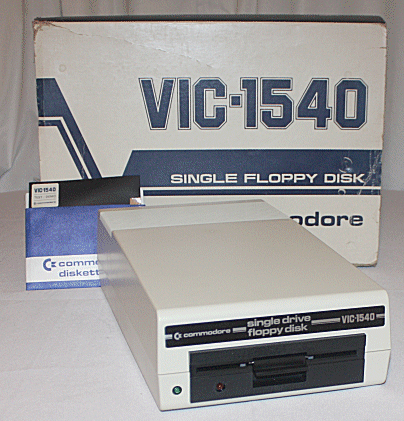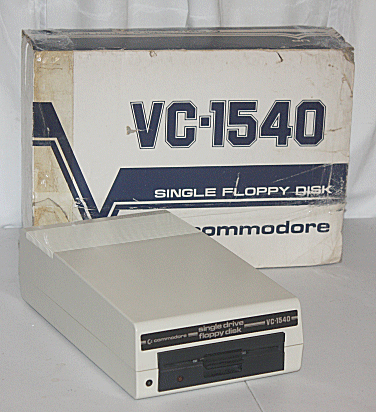



Commodore VIC-1540 & VC-1540

With the release of the low priced VIC-20, Commodore rushed to follow
it up with an equally inexpensive disk drive. The Commodore 1540
was the result. Strangely enough, the 1540 must have been too expensive
even still, as they are very rare in their original VIC-20 formulation.
The 1540 was the first disk drive on the new Commodore
serial bus. Unfortunately, due to a timing error in the new I/O
chips, the engineers were forced to slow down the throughput of this
drive considerably. When the Commodore 64 was designed, instead of
fixing this problem, Commodore decided to keep the C64 compatible
with this disk drive by slowing it down as well.
Ironically, the C64 serial bus had to be slowed even further due to
a conflict with the new VIC-II video chip, making the C64 incompatible
with the 1540 anyway (unless one disabled the VIC-II video chip
temporarily using software).
The German counterpart to the VIC-1540 was the VC-1540. You might want
to check out the VC-20 page for some speculation
on the name difference.
Although these disk drives used a new serial interface, the principle design of
Commodore disk drives and CBM DOS remained the same.
Like all Commodore disk drives, these drives were "smart" devices. They included
their own processor, their own memory, and their own disk operating system. In fact,
the relationship between a Commodore computer and it's disk drive resembles more
closely two computers on a network than a typical Computer->peripheral relationship.
The peripherals on the Commodore serial "network" each had a unique identifying "Unit" number,
typically ranging from 8-30. This number identified which physical device was
being accessed. When a disk drive contained more than one floppy drive (like the
1572 for instance), you also had to refer to the particular "drive" number
you wanted (typically 0 or 1). Single-floppy drives, like the ones on this page, still
had to deal with the legacy of the old IEEE-488 dual drives and the version of CBM
DOS with which they were compatible by referring to their single floppy as "drive 0".
Model : VIC-1540
Type : 5.25" Floppy Disk
Media : Single Sided, Single Density
Capacity : 170K per disk
Interface: CBM Serial Bus
Dos : CBM DOS 2.6
Notes :

Model : VC-1540
Type : 5.25" Floppy Disk
Media : Single Sided, Single Density
Capacity : 170K per disk
Interface: CBM Serial Bus
Dos : CBM DOS 2.6
Notes :
If you find anything in here you have questions or comments about, feel
free to leave me email right here.
To return to my home page, click here.


